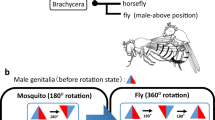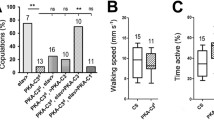Abstract
We present the isolation and functional analysis of a transformer2 homologue Mdtra2 in the housefly Musca domestica. Compromising the activity of this gene by injecting dsRNA into embryos causes complete sex reversal of genotypically female individuals into fertile males, revealing an essential function of Mdtra2 in female development of the housefly. Mdtra2 is required for female-specific splicing of Musca doublesex (Mddsx) which structurally and functionally corresponds to Drosophila dsx, the bottom-most regulator in the sex-determining pathway. Since Mdtra2 is expressed in males and females, we propose that Mdtra2 serves as an essential co-factor of F, the key sex-determining switch upstream of Mddsx. We also provide evidence that Mdtra2 acts upstream as a positive regulator of F supporting genetic data which suggest that F relies on an autocatalytic activity to select and maintain the female path of development. We further show that repression of male courtship behavior by F requires Mdtra2. This function of F and Mdtra2 appears not to be mediated by Mddsx, suggesting that bifurcation of the pathway at this level is a conserved feature in the genetic architecture of Musca and Drosophila.







Similar content being viewed by others
References
Amrein H, Gorman M, Nöthiger R (1988) The sex-determining gene tra-2 of Drosophila encodes a putative RNA binding protein (published erratum appears in Cell 1989 Jul 28; 58(2) :following 419). Cell 55:1025–1035
Amrein H, Maniatis T, Nöthiger R (1990) Alternatively spliced transcripts of the sex-determining gene tra-2 of Drosophila encode functional proteins of different size. EMBO J 9:3619–3629
Amrein H, Hedley ML, Maniatis T (1994) The role of specific protein-RNA and protein-protein interactions in positive and negative control of pre-mRNA splicing by Transformer 2. Cell 76:735–746
Baker BS, Wolfner MF (1988) A molecular analysis of doublesex, a bifunctional gene that controls both male and female sexual differentiation in Drosophila melanogaster. Genes Dev 2:477–489
Beil B, Screaton G, Stamm S (1997) Molecular cloning of htra2-beta-1 and htra2-beta-2, two human homologs of tra-2 generated by alternative splicing. DNA Cell Biol 16:679–690
Bell LR, Horabin JI, Schedl P, Cline TW (1991) Positive autoregulation of Sex-lethal by alternative splicing maintains the female determined state in Drosophila. Cell 65:229–239
Burtis KC, Baker BS (1989) Drosophila doublesex gene controls somatic sexual differentiation by producing alternatively spliced mRNAs encoding related sex-specific polypeptides. Cell 56:997–1010
Chandler D, McGuffin ME, Piskur J, Yao J, Baker BS, Mattox W (1997) Evolutionary conservation of regulatory strategies for the sex determination factor transformer-2. Mol Cell Biol 17:2908–2919
Cline TW, Meyer BJ (1996) Vive la différence: males vs females in flies vs worms. Annu Rev Genet 30:637–702
Dauwalder B, Amaya-Manzanares F, Mattox W (1996) A human homologue of the Drosophila sex determination factor transformer-2 has conserved splicing regulatory functions. Proc Natl Acad Sci USA 93:9004–9009
Dubendorfer A, Hediger M (1998) The female-determining gene F of the housefly, Musca domestica, acts maternally to regulate its own zygotic activity. Genetics 150:221–226
Dubendorfer A, Hediger M, Burghardt G, Bopp D (2002) Musca domestica, a window on the evolution of sex-determining mechanisms in insects. Int J Dev Biol 46:75–79
Fortier E, Belote JM (2000)Temperature-dependent gene silencing by an expressed inverted repeat in Drosophila. Genesis 26:240–244
Goralski TJ, Edstrom JE, Baker BS (1989) The sex determination locus transformer-2 of Drosophila encodes a polypeptide with similarity to RNA binding proteins. Cell 56:1011–1018
Hall JC (1994) The mating of a fly. Science 264:1702–1714
Hazelrigg T, Tu C (1994) Sex-specific processing of the Drosophila exuperantia transcript is regulated in male germ cells by the tra-2 gene. Proc Natl Acad Sci USA 91:10752–10756
Hediger M, Niessen M, Wimmer EA, Dubendorfer A, Bopp D (2001) Genetic transformation of the housefly Musca domestica with the lepidopteran derived transposon piggyBac. Insect Mol Biol 10:113–119
Hediger M, Burghardt G, Siegenthaler C, Buser N, Hilfiker-Kleiner D, Dubendorfer A, Bopp D (2004) Sex determination in Drosophila melanogaster and Musca domestica converges at the level of the terminal regulator doublesex. Dev Genes Evol 214:29–42
Hedley ML, Maniatis T (1991) Sex-specific splicing and polyadenylation of dsx pre-mRNA requires a sequence that binds specifically to tra-2 protein in vivo. Cell 65:579–586
Heinrichs V, Ryner LC, Baker BS (1998) Regulation of sex-specific selection of fruitless 5′ splice sites by transformer and transformer-2. Mol Cell Biol 18:450–458
Hertel KJ, Lynch KW, Hsiao EC, Liu EH, Maniatis T (1996) Structural and functional conservation of the Drosophila doublesex splicing enhancer repeat elements. RNA 2:969–981
Hilfiker-Kleiner D, Dübendorfer A, Hilfiker A, Nöthiger R (1993) Developmental analysis of two sex-determining genes, M and F, in the housefly, Musca domestica. Genetics 134:1189–1194
Hilfiker-Kleiner D, Dubendorfer A, Hilfiker A, Nothiger R (1994) Genetic control of sex determination in the germ line and soma of the housefly, Musca domestica. Development 120:2531–2538
Hoshijima K, Inoue K, Higuchi I, Sakamoto H, Shimura Y (1991) Control of doublesex alternative splicing by transformer and transformer-2 in Drosophila. Science 252:833–836
Inoue K, Hoshijima K, Sakamoto H, Shimura Y (1990) Binding of the Drosophila sex-lethal gene product to the alternative splice site of transformer primary transcript. Nature 344:461–463
Ito H, Fujitani K, Usui K, Shimizu-Nishikawa K, Tanaka S, Yamamoto D (1996) Sexual orientation in Drosophila is altered by the satori mutation in the sex-determination gene fruitless that encodes a zinc finger protein with a BTB domain. Proc Natl Acad Sci USA 93:9687–9692
Kohtz JD, Jamison SF, Will CL, Zuo P, Luhrmann R, Garcia-Blanco MA, Manley JL (1994) Protein-protein interactions and 5′-splice-site recognition in mammalian mRNA precursors. Nature 368:119–124
Lam BJ, Bakshi A, Ekinci FY, Webb J, Graveley BR, Hertel KJ (2003) Enhancer-dependent 5′-splice site control of fruitless pre-mRNA splicing. J Biol Chem 278:22740–22747
Lynch K, Maniatis T (1995) Synergistic interactions between two distinct elements of a regulated splicing enhancer. Genes Dev 9:284–293
Lynch KW, Maniatis T (1996) Assembly of specific SR protein complexes on distinct regulatory elements of the Drosophila doublesex splicing enhancer. Genes Dev 10:2089–2101
Madigan SJ, Edeen P, Esnayra J, McKeown M (1996) att, a target for regulation by tra2 in the testes of Drosophila melanogaster, encodes alternative RNAs and alternative proteins. Mol Cell Biol 16:4222–4230
Manley JL, Tacke R (1996) SR proteins and splicing control. Genes Dev 10:1569–1579
Mattox W, Baker BS (1991) Autoregulation of the splicing of transcripts from the transformer-2 gene of Drosophila. Genes Dev 5:786–796
Mattox W, Palmer MJ, Baker BS (1990) Alternative splicing of the sex determination gene transformer-2 is sex-specific in the germ line but not in the soma. Genes Dev 4:789–805
Mattox W, McGuffin ME, Baker BS (1996) A negative feedback mechanism revealed by functional analysis of the alternative isoforms of the Drosophila splicing regulator transformer-2. Genetics 143:303–314
McDonald IC, Evenson P, Nickel CA, Johnson OA (1978) House fly genetics: isolation of a female determining factor on chromosome 4. Ann Entomol Soc Am 71:692–694
McGregor AP, Shaw PJ, Hancock JM, Bopp D, Hediger M, Wratten NS, Dover GA (2001) Rapid restructuring of bicoid-dependent hunchback promoters within and between Dipteran species: implications for molecular coevolution. Evol Dev 3:397–407
McGuffin ME, Chandler D, Somaiya D, Dauwalder B, Mattox W (1998) Autoregulation of transformer-2 alternative splicing is necessary for normal male fertility in Drosophila. Genetics 149:1477–1486
Meise M, Hilfiker-Kleiner D, Dubendorfer A, Brunner C, Nothiger R, Bopp D (1998) Sex-lethal, the master sex-determining gene in Drosophila, is not sex-specifically regulated in Musca domestica. Development 125:1487–1494
Nöthiger R, Steinmann-Zwicky M (1985) A single principle for sex determination in insects, vol 50. Cold Spring Harbor Symposium, Cold Spring Harbor, N.Y., pp 615–621
Pane A, Salvemini M, Delli Bovi P, Polito C, Saccone G (2002) The transformer gene in Ceratitis capitata provides a genetic basis for selecting and remembering the sexual fate. Development 129:3715–3725
Parkhurst SM, Meneeley PM (1994) Sex determination and dosage compensation: lessons from flies and worms. Science 264:924–932
Perje A-M (1948) Studies on the spermatogenesis in Musca domestica. Hereditas 34:209–232
Rubini PG, Franco MG, Vanossi Este S (1972) Polymorphisms for heterochromosomes and autosomal sex-determinants in Musca domestica L. Atti IX Congr Naz It Entomol 9:341–352
Ryner LC, Baker BS (1991) Regulation of doublesex pre-mRNA processing occurs by 3′ splice site activation. Genes Dev 5:2071–2085
Ryner LC, Goodwin SF, Castrillon DH, Anand A, Villella A, Baker BS, Hall JC, Taylor BJ, Wasserman SA (1996) Control of male sexual behavior and sexual orientation in Drosophila by the fruitless gene. Cell 87:1079–1089
Saccone G, Peluso I, Artiaco D, Giordano E, Bopp D, Polito LC (1998) The Ceratitis capitata homologue of the Drosophila sex-determining gene sex-lethal is structurally conserved, but not sex-specifically regulated. Development 125:1495–1500
Saccone G, Pane A, Polito LC (2002) Sex determination in flies, fruitflies and butterflies. Genetica 116:15–23
Schmidt R, Hediger M, Nöthiger R, Dübendorfer A (1997) The mutation masculinizer (man) defines a sex determining gene with maternal and zygotic functions in Musca domestica L. Genetics 145:173–183
Schutt C, Nothiger R (2000) Structure, function and evolution of sex-determining systems in dipteran insects. Development 127:667–677
Sosnowski BA, Belote JM, McKeown M (1989) Sex-specific alternative splicing of RNA from the transformer gene results from sequence-dependent splice site blockage. Cell 58:449–459
Tautz D, Pfeifle C (1989) A non-radioactive in situ hybridization method for the localization of specific RNAs in Drosophila embryos reveals translational control of the segmentation gene hunchback. Chromosoma 98:81–85
Taylor BJ, Villella A, Ryner LC, Baker BS, Hall JC (1994) Behavioral and neurobiological implications of sex-determining factors in Drosophila. Dev Genet 15:275–296
Tian M, Maniatis T (1993) A splicing enhancer complex controls alternative splicing of doublesex pre-mRNA. Cell 74:105–114
Wu JY, Maniatis T (1993) Specific interactions between proteins implicated in splice site selection and regulated alternative splicing. Cell 75:1061–1070
Acknowledgements
We are deeply indebted to Dr. Rolf Nöthiger for his continuing support and for many stimulating discussions. We also thank him and Dr. Mary Bownes for helpful comments on this manuscript. Mark Robertson and Dr. Peter Atkinson (Department of Entomology, University of California, Riverside, USA) are gratefully acknowledged for providing degenerate primers and cloning strategies. We thank Simone Kaeppeli for sharing unpublished results. We thank Claudia Brunner for technical assistance and Johanna Nägeli and Raymond Grunder for Musca stock keeping. This work was supported by a grant of the Swiss National Foundation (31-67993.02).
Author information
Authors and Affiliations
Corresponding author
Additional information
Edited by D. Tautz
Rights and permissions
About this article
Cite this article
Burghardt, G., Hediger, M., Siegenthaler, C. et al. The transformer2 gene in Musca domestica is required for selecting and maintaining the female pathway of development. Dev Genes Evol 215, 165–176 (2005). https://doi.org/10.1007/s00427-004-0464-7
Received:
Accepted:
Published:
Issue Date:
DOI: https://doi.org/10.1007/s00427-004-0464-7




